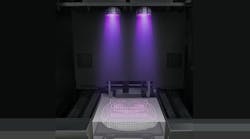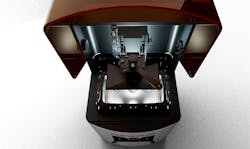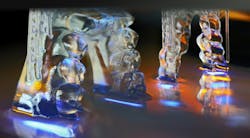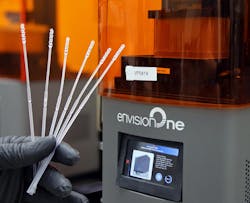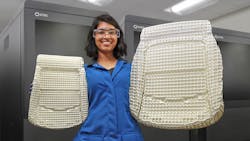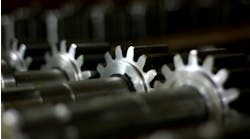The Ultimate Guide to Digital Light Processing (DLP) Polymer 3D Printing
- Why DLP is the fastest, smartest way to 3D print with light
- About the latest updates in DLP printer designs
- Why a new category of DuraChain resins is a breakthrough
- Important considerations for DLP light engines
- Why DLP technology is ready for volume production of end-use parts
Introduction
Digital Light Processing, or DLP, harnesses the power of light from a video projector to cure photosensitive liquid resins into parts layer by layer, one quick flash at a time.
A 3D printing process that’s been used since 1999, DLP was invented as a significant speed advancement over stereolithography, or SLA, which cures photosensitive resin with UV light from a laser beam, drawing parts out individually one layer at a time.
More than 20 years later, DLP is one of the more mature processes in the field of 3D printing. Today, this highly affordable, accurate, and high-speed printing technology is used for everything from prototyping to volume production of end-use parts, including those with demanding precision, surface finish, and functional requirements.
Initially used for the production of mass-customized hearing aid shells and functional dental restorations, such as dentures and crowns that go right in the mouth for biting and chewing, the technology is now used widely in manufacturing for tooling and casting applications as well as for direct production across a wide range of industries and end-use applications.
In fact, the speed and accuracy of DLP printing is now so powerful that it has truly become a standard manufacturing tool. An increasing number of dentists, audiologists, jewelers, and industrial manufacturers use DLP printers in their offices or on their factory floors—demonstrating the potential of this fast and accurate polymer printing technology to transform manufacturing, not only for customized parts but for on-demand replacement of spare parts and serial production needs.
When the COVID pandemic started sweeping the globe in late 2019, it was often DLP printers that filled the urgent demand for the production of nose swabs and valves for respirators.
New Developments in DLP
Over these past two decades, the landscape of DLP technology offerings has also dramatically changed—from the mechanical design of the printing systems and the processing strategies used, to the materials they process.
While there are now more DLP printers than ever available at affordable prices, the premium end of the market for serious manufacturers has continued to innovate in ways that enable DLP to advance into the volume production of end-use parts, or Additive Manufacturing 2.0. Industrial-grade DLP systems can now crank out durable, end-use parts with volumes and costs that compete with traditional manufacturing while offering once-impossible design and supply chain advantages for which 3D printing is well known.
While improvements in machine design have played a key role in enabling this next era of DLP printing, advances in material properties have been equally critical, if not more so. For a long time, DLP printing produced incredibly smooth and accurate parts that were also fairly brittle, shattered easily, or experienced diminishing performance and mechanical properties over time.
The competitive field of material science has raced to solve these challenges, especially as the adoption of DLP printers has surged in the market. Now, with innovations such as DuraChain resins, DLP can produce tough and durable elastomers that compete with thermosets—delivering rubber and silicone-like properties, even a true closed-cell foam.
This white paper is a comprehensive overview of the fast-changing DLP marketplace, updated for 2022, with a quick overview of the past and a deep dive into the most significant machine and material advances of today.
Here's what you'll find in the guide:
- The History of DLP
- DLP is Born as a Problem Solver
- The Benefits of Area-Wide 3D Printing
- Machine Design
- Bottom-Up DLP Printing
- New Efficiencies in DLP Machine Design and Process
- The Launch of Hyperprint
- Top-Down DLP
- The Importance of the Light Engine
- Process Considerations
- From Pixels to Voxels
- Anti-Aliasing and Pixel-Shifting Technology
- Understanding Photopolymer Materials
- A Breakthrough New Category of Photopolymers
- Application Examples
- PCB Housing
- Flow Adapter Housing
Click the download button below to read the full guide to DLP 3D printing.
ETEC (envisionTEC), a Desktop Metal brand, is a global provider of professional-grade 3D printing solutions. As the original inventor of digital light processing (DLP) 3D printing technology, ETEC has one of the most advanced portfolios of precision polymer printers and materials in the market today.
